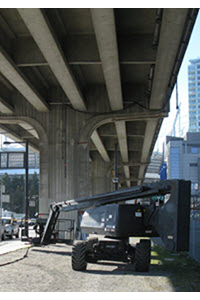Worker seriously injured when boom lift lowered
Date of incident: March 2020
Notice of incident number: 2020178040003
Employer: Motion picture and television agency
Incident summary
On a location set of a television production site, cables were being installed under a viaduct (a bridge carrying a road) in preparation for filming. An articulating boom lift was being used for the task. During the installation of the cables, a film industry worker (a production assistant) was positioned under the viaduct near the operation area of the lift. A worker on the lift lowered it to retrieve more cables. As he lowered the lift, its platform struck the production assistant, who sustained serious injuries.
Investigation conclusions
Cause
- Worker with no high‑visibility apparel working in close proximity to mobile equipment. The production assistant was not wearing high‑visibility apparel and inadvertently stood under the lift. The workers in the lift were unaware that the production assistant was under the lift. They did not see the production assistant through the grated floor of the occupant platform. The production assistant had not been instructed regarding the hazards associated with overhead work and was not provided with adequate supervision.
Contributing factors
- Inadequate hazard assessment. The risk of injury from mobile equipment and overhead work was not identified as a hazard to workers and was not included in the hazard checklist. Failure to identify the hazards of working around mobile equipment and under overhead work was found to have contributed to the incident.
- Lack of appropriate personal protective equipment. At the time of the incident, the production assistant was not wearing a high-visibility vest, which hindered the workers in the lift from seeing the production assistant through the grated floor of the platform. In addition, the production assistant was not wearing a hard hat where overhead work was being performed.
- Inadequate supervision. The production assistant’s supervisor was not on site at the time of the incident. The supervisors for the lift workers were also not on site at the time of the incident. The production assistant was not provided with an adequate worksite orientation or advised of the hazard checklist.
- Inadequate site orientation and communication. The production assistant and the lift workers were not adequately provided with a site orientation. The worksite had multiple departments working together without a supervisor coordinating the entire site. The heads of the different departments did not communicate with each other. The lift workers were not provided with an explanation of the production assistant’s role.
- Failure to adequately implement occupational health and safety program. The employer failed to follow aspects of its own safety program. The employer failed to ensure all workers were aware of the foreseeable hazards at the worksite, identify all hazards and risks to workers, and distribute or communicate the hazard checklist to all workers. The employer identified the need for spotters to ensure the area around lifts is coned or taped off and safe. A spotter was not used, and there was a lack of clarity as to which department head was responsible for ensuring a spotter was in place.
2021-04-22 20:42:33

